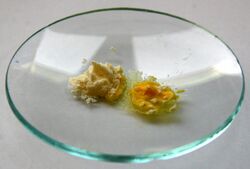Chemistry:Xanthoproteic acid
Xanthoproteic acid is a noncrystallizable yellow substance derived from proteins upon treatment with nitric acid. Nitric acid reacts with proteins to form yellow nitrated products. This reaction is known as the xanthoproteic reaction. This test is carried out by adding concentrated nitric acid to the substance being tested, and then heating the mixture. If proteins are present that contains amino acids with aromatic rings, the mixture turns yellow. Upon adding a strong base such as liquid ammonia, the color turns orange. These color changes are caused by nitrated aromatic rings in the protein. The xanthoproteic test is specific for aromatic compounds such as tyrosine, tryptophan and phenylalanine.
Xanthoproteinic acids are also formed when the acid contacts epithelial cells (typically the fingers) and are a certain giveaway of inadequate care when handling nitric acid. Minor stains are harmless and resolve in a few days. It is a mixture of nitro compounds of tyrosine, tryptophan, and phenylalanine such as [2-amino-3-(4-hydroxy-3-nitrophenyl)propionic acid, [2-amino-3-(4-nitroindolyl-3)propionic acid, and others.
This article does not cite any external source. HandWiki requires at least one external source. See citing external sources. (2021) (Learn how and when to remove this template message) |
 |


